Blog
Conference Report: National Nerves
Last week I went to the Romance Writers of America’s national conference in Washington, D.C.
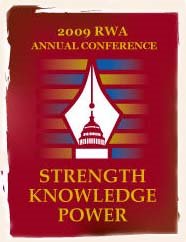
Ordinarily, I only attend when the event is in New York City since getting there from New Jersey requires no white-knuckled, gut-twisting flight on an airplane (one of those metal tubes hurtling through thin air 30,000 feet above the safe, solid ground). However, there’s a wonderful invention called the Acela train which sweeps you smoothly–with tons of leg room and a plug for your laptop–between Newark, NJ, (no security check required—just waltz onto the platform fifteen minutes before boarding time) and the nation’s capitol. And I have friends and relatives in D.C. so the trip offered several temptations beyond the conference itself.
There was one more variable in my decision: presenting a workshop. I have given workshops for several regional writers’ groups and they’ve always gone pretty well so I thought maybe I was ready for the big time. I would submit a workshop proposal to RWA. If it was accepted, I would go to Washington; if it wasn’t, I would stay home. It was my own weird version of a coin toss.
I chose my most esoteric workshop topic because I figured no one else would be submitting a competing one: How Do I Love Thee: Using the Techniques of Poetry to Strengthen your Prose. Not a lot of folks spent three years in college writing poetry and then metamorphosed into a romance writer (although more than you’d think, as I discovered at my presentation). Since I’ve given the workshop before, I already had handouts and a short description of the workshop. I uploaded the info and forgot all about it.
Until I got an email from RWA, saying my proposal had been accepted and I would be presenting it at 4:30 on Thursday, July 16th.
Excited, I made my reservation on the Acela, called my relatives and friends to set up dinner dates, and then it hit me: I had to stand up and speak in front of a room full of writers at all levels of experience from all over the world. Even worse, it would be recorded so writers at all levels of experience from all over the world could download and listen to it, long after the conference was over. My West Virginia twang, my ums and ahs, the deafening silences when I asked the audience to participate would all be preserved for posterity.
AAAAAAAAAAAGGGGGGHHHHHHHHHH! What was I thinking?!
Long story short: I survived the workshop, thanks to my wonderful moderator Roni Denholtz who kept me calm and to a truly terrific audience who participated with talent and enthusiasm. I would even go so far as to say it went pretty well. The best part: it was OVER and I could enjoy the rest of the conference without losing any more sleep.
Brodie update

Here’s my adorable niece Jessica, giving Brodie his favorite thing: a belly rub. Turns out the Devil Dog is amazingly good with children. Who’d a thunk?
Brodie is finally settling in. He’s a rub junkie and will melt into the floor with a moan of ecstasy if you pet him. He’s so incredibly cute that it’s hard not to pet him, a genetic adaptation that clearly serves him well.
He’s still digging a bit in the yard but hasn’t eaten any plants lately. I think he’s bonded enough with us at last that he cares about our opinion of his actions.
“Come” is still an alien concept to him, but he’s doing much better on “heel”, especially since we put a “gentle leader” halter on him. Works like a charm. He even goes jogging with my Darling Daughter now that she’s home from college.
Truly, Brodie is such a sweetheart. Our home would be empty without him.
You know you’ve arrived when…
…you find your book being quoted in someone else’s book.

I was delighted to discover that Michael Aaron Rockland devotes a page and a half to my first novel A Bridge to Love in his book about the George Washington Bridge. Mr. Rockland’s book The George Washington Bridge, Poetry in Steel is “a well-rounded tribute to a national landmark”, according to one critic. The book “weaves together history, popular culture, behind-the-scenes tours and personal insight in his living portrait of a modern marvel.”
“Popular culture” is where A Bridge to Love comes in. A whole chapter is devoted to the GWB “in literature” and my novel appears on page 110.
Because he’s a college professor and therefore a very serious thinker, Mr. Rockland throws in the usual snarky remarks about the traditions of the romance novel. However, he goes on to say, “The George Washington Bridge is more central to this novel than to any other I’ve found,” and that “Herkness, a resident of New Jersey, obviously did some research on the nearby bridge,” which I think he meant as a compliment.
He then quotes extensively from my book, picking out some of my own favorite lines in reference to the great bridge. My novel and all the pages referenced appear in the scholarly notes at the back of his book.
Wahoo! I’m a source!
Out of the mouths of babes…
My Darling Daughter brought home a literary magazine from Kenyon College called Hika, An Undergraduate Journal of Arts and Letters. Following is my favorite poem from the journal. The poet speaks of a truly universal truth.
Procrastination Takes on Newton’s Laws of Motion in a Cage Fight and Wins
I have yet to find
an oppositional
force equal to
my desire to
not get things
done.
— Katharine Parrott
Going back, going back…
I just returned from my mrmph-th (that’s the sound of me muffling the number of years since my graduation) college reunion. It struck me that no one would truly believe what a major, insane production my college makes of reunions if I didn’t show you some photos. So here they are.
My outfit. This is my suitcase. Do you detect a theme?

More on the outfit. Nail art by my darling daughter. Did I mention my school’s mascot is a tiger?
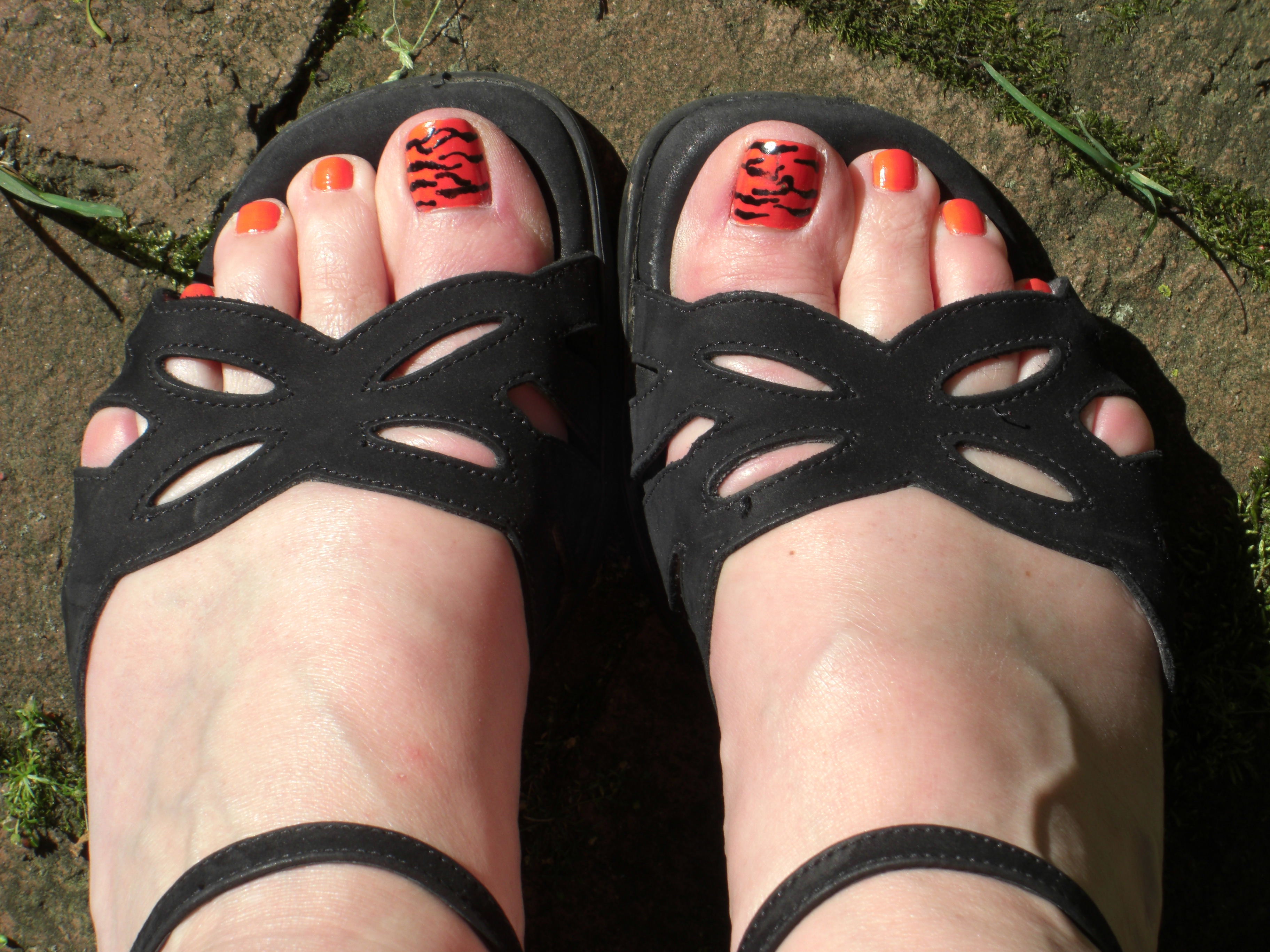
The decorations in the reunions tent, one of many mushroomed through the campus.
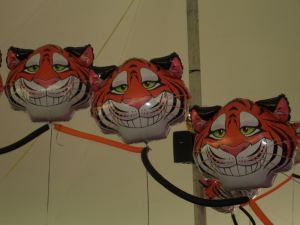
The Prade. Every alum and their families, including dogs, marches down the center of campus being cheered by all the other alums and their families and dogs.
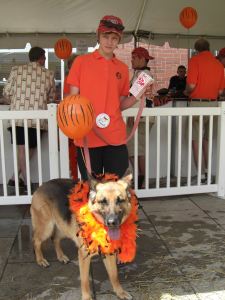
Here’s my class watching the older classes go by in the Prade. Of course, we were also talking, catching up on mrmph years of news.

Here’s my favorite outfit in the marching band.
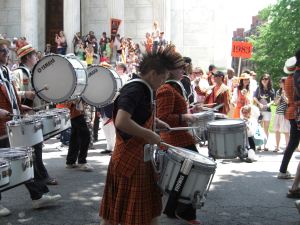
My class float.
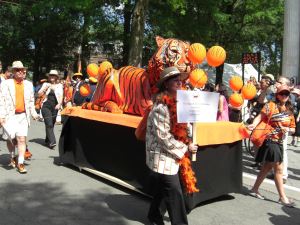
Here’s my view once my class started marching. A lot of folks came back.
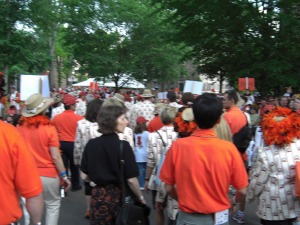
Finally, as embarassing as it is, here’s a picture of me in my class costume, looking as ridiculous as everyone else in the Prade.
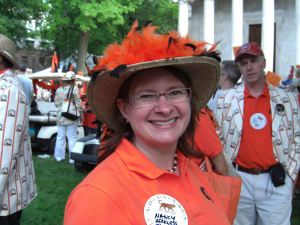
Feather boas are really itchy so I turned mine into a hatband. It had the added advantage of weighting my hat down when the breeze got brisk.
Prize: Although there are major clues scattered all through my post, you may have noticed that I don’t mention where all this insanity took place. If you can guess what college I attended, send me an email at nancy@nancyherkness.com. Put “Reunion” in the subject line. Everyone who guesses correctly will be entered in a drawing for a prize.
Note: this morning, I went through my closet to find something to wear and realized I had chosen beige from head to toe. I’m thinking it’s an antidote to my weekend wardrobe.
What is it about a marching band?
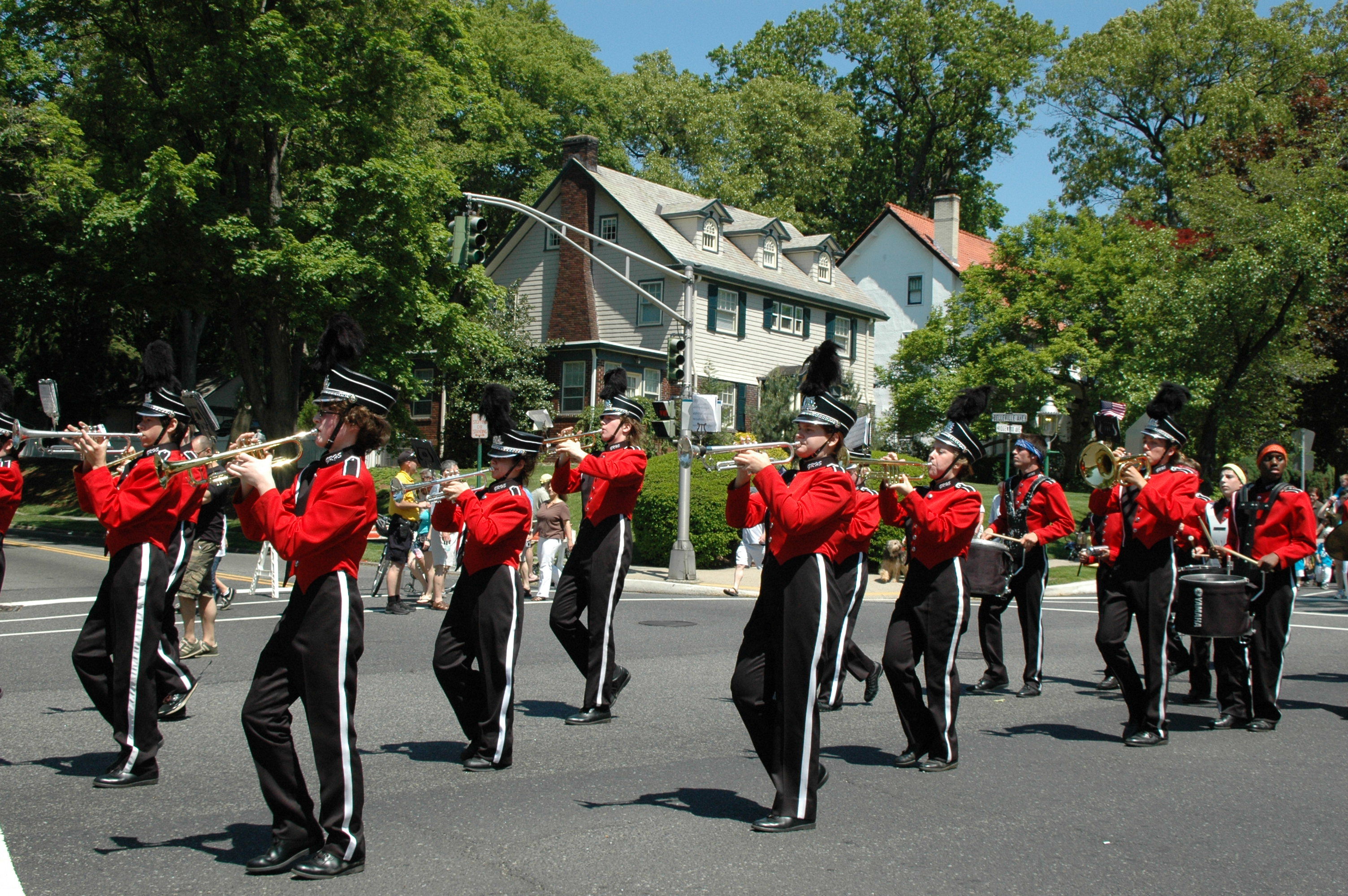
I’m a recovering band parent. My daughter graduated from high school and the marching band last year. However, at the Memorial Day Parade in our small town today, my heart still thrilled to the sound of John Phillip Sousa, played as the band marched crisply down our main street. Tears still filled my eyes when the trumpeters played “Taps”, even though my daughter is no longer one of the performers.
Music tugs at some deep part of our hearts and souls. Every culture has music in some form. Human beings can’t seem to survive without it. But why a marching band?
My theory is that it’s the teamwork. A diverse group of individuals has to work together in perfect unison to create a marching band. Maybe it’s because writing is a solitary profession so I find that sort of connection enviable. Or maybe it’s because I admire the willingness of the individual to merge his identity into the good of the whole.
No matter what the reason, I love a parade.
World’s best prequel: Star Trek
 My Mother’s Day gift was a family outing to see the new Star Trek movie. Since I was a trekkie in my younger years, I went with a certain amount of fear and trembling. Telling the story of how my favorite starship crew first met and bonded seemed rife with the potential for disaster. I mean I’ve known and loved these characters since I was about ten. Could a modern casting director really know what they looked like, spoke like and moved like when they were younger versions of themselves? Could a modern scripwriter postulate how their chemistry had fizzed into being?
My Mother’s Day gift was a family outing to see the new Star Trek movie. Since I was a trekkie in my younger years, I went with a certain amount of fear and trembling. Telling the story of how my favorite starship crew first met and bonded seemed rife with the potential for disaster. I mean I’ve known and loved these characters since I was about ten. Could a modern casting director really know what they looked like, spoke like and moved like when they were younger versions of themselves? Could a modern scripwriter postulate how their chemistry had fizzed into being?
The answer is a resounding, “Yes!” They really got it right!
The references to events we know and love, the interactions between the characters which foreshadow their future relationships, the action sequences where the Enterprise saves the day: it’s all there and all pitch perfect.
I’m going to see it again.
A Nod from Nancy: Seahawk, Confessions of an Old Hockey Goalie by Bruce Valley
This book surprised me–in a good way. A publicist  contacted me out of the blue and asked if I would review it. I was a little nervous because I prefer to write positively about books and I didn’t have any idea what to expect from Seahawk. Below is an excerpt from my review. If you’d like to read the full review, it’s on Amazon.
contacted me out of the blue and asked if I would review it. I was a little nervous because I prefer to write positively about books and I didn’t have any idea what to expect from Seahawk. Below is an excerpt from my review. If you’d like to read the full review, it’s on Amazon.
Seahawk is a love story. It’s about the love of hockey in its purest form: pond hockey, or “shinny” as it was called in Rye, New Hampshire in the 1940s, played outdoors on the most elemental of surfaces: “black ice”. It’s about how a group of World War II veterans who loved the game gave a small town a sense of pride and identity, starting a hockey team from scratch and turning it into a powerhouse that made it all the way to the Class B championships in Boston Garden. Finally, it’s about one man’s life-long passion for the game from his days as a fourteen-year-old goalie with the Seahawks to his debate about when it’s time to hang up the pads.
Although author Bruce Valley is a former test pilot and an aerospace executive, he’s also a poet and it shows in this memoir. He writes with profound emotion and insight about the hockey-playing war veterans he hero-worshipped when he was young, and admired even more when he grew up to understand the sacrifices they had made. He paints the depth of devotion required to keep a team going when Mother Nature repeatedly threw her worst at their home-made outdoor “pond”. He vividly describes the wide-eyed fascination he felt when he saw his first game of “shinny” at age three and how that excitement has never left him. I often found myself reading with tears in my eyes, not an experience one usually associates with a book on the intense, hard-charging sport of hockey.
What do you do with a llama?
While visiting my Darling Daughter at her college in the cornfields of Ohio, I was delighted and intrigued by three llamas wandering about in a field we drove past. I stopped to say hello and got greeted with much interest by the Head Llama (below) who found my camera irresistible.
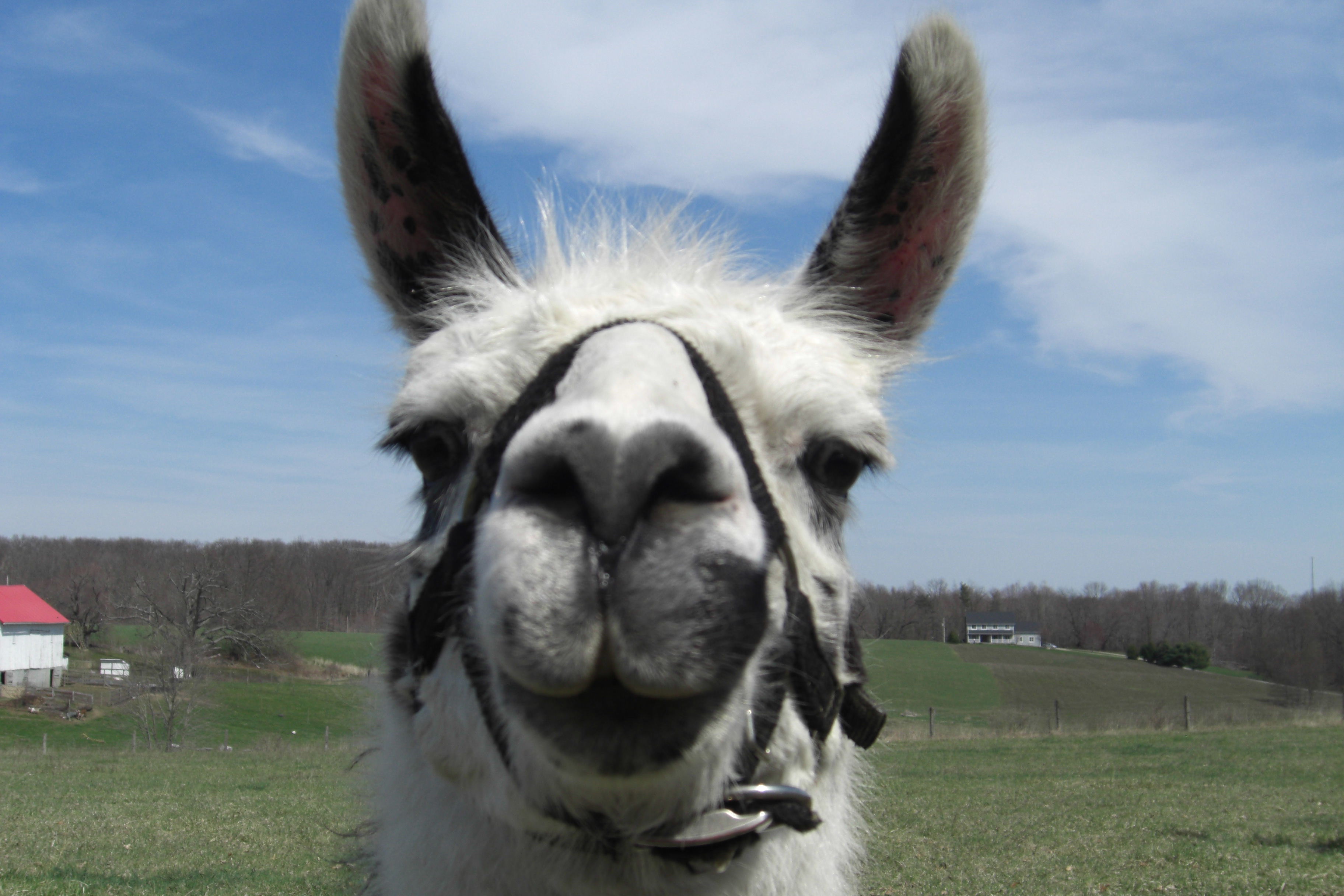
As I communed with the Head Llama I began to wonder what exactly one keeps a llama around for. So when I got to a computer I asked the internet. Here’s what I found:
Llamas are camelids, along with the alpaca, the guanaco, and the vicuna. They’re thought to be related to the Bactrian and Dromedary camels of Asia. Baby llamas are called “crias’.
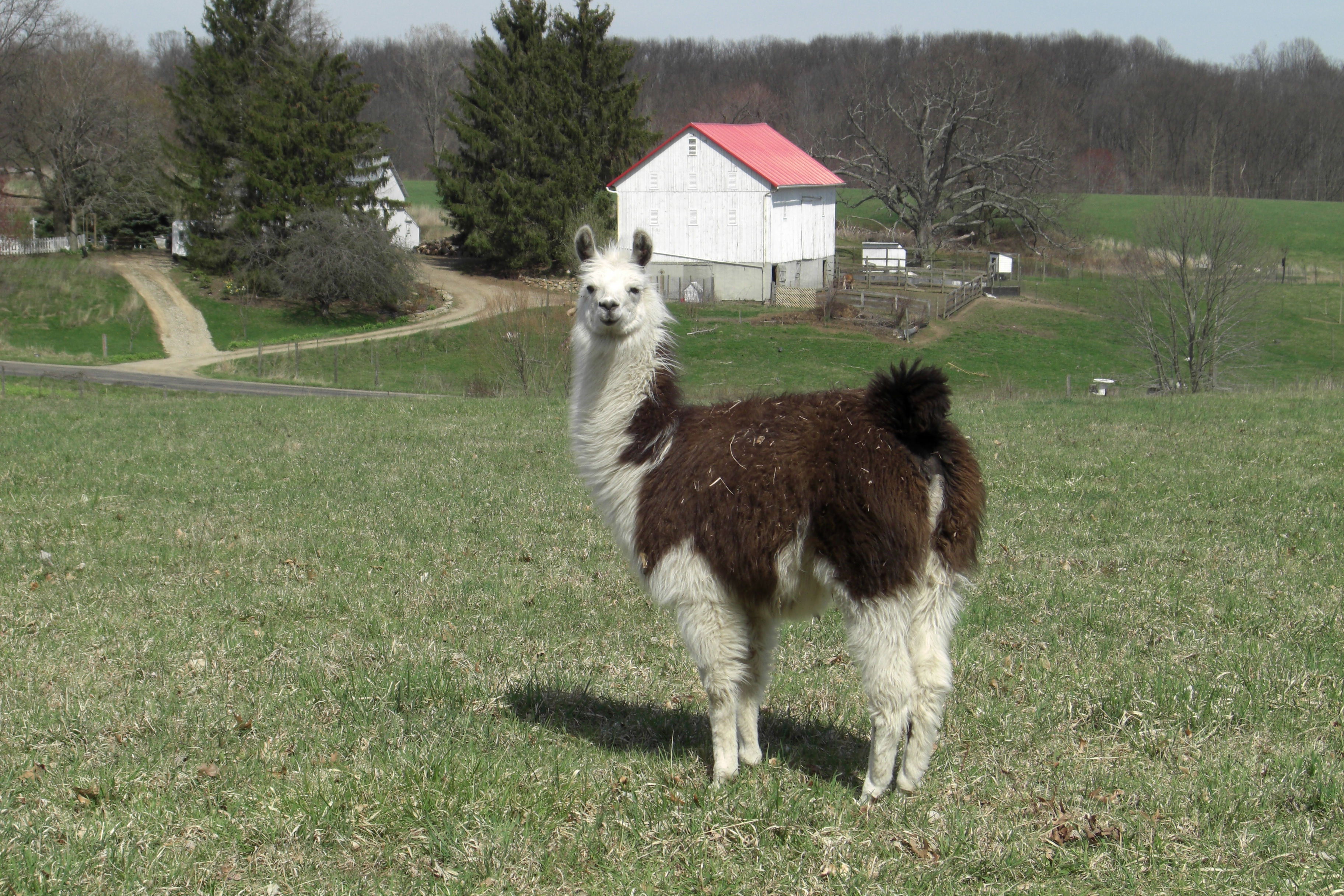
They make excellent pets and companions because of their “low-key temperament, intelligence and ease of maintenance.” The latter assumes you have large fields around your house; I don’t think it would so easy to maintain one in suburban New Jersey. They make wonderful hiking and jogging companions (I’m not joking–I got this information from a llama website).
Llamas are terrific pack animals because of their “thriftiness” which I think goes back to the low-maintenance thing. Evidently they are in demand for wilderness packing in the mountainous regions of the western United States. You can also hitch your llama to a cart and ride around in it.
Their wool is very nice although not used for mass production. They have been known to keep predators away from flocks of sheep. Llamas can also be eaten although that seems sort of creepy if they are your jogging companions and the guardians of your sheep.
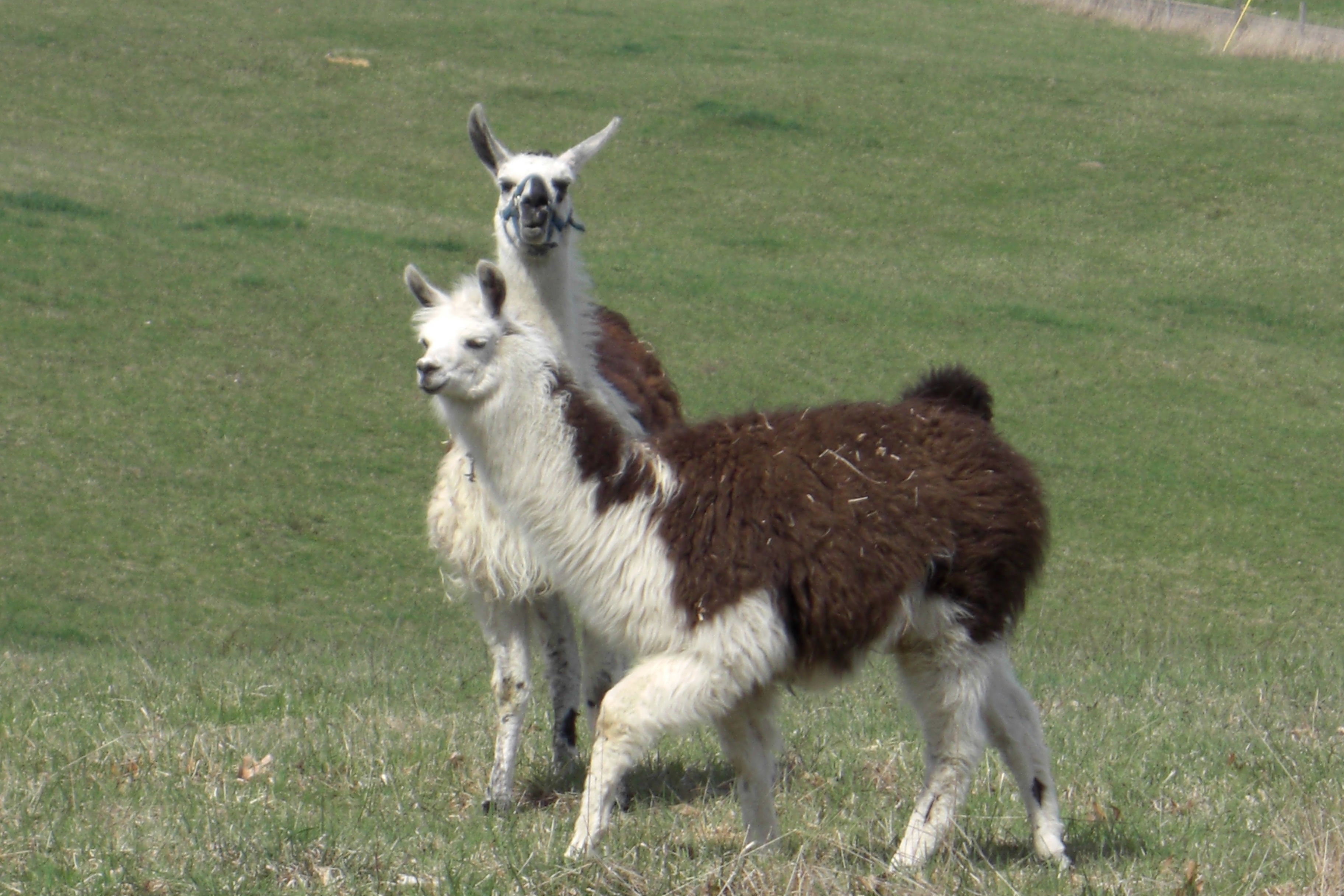
I guess the main reason to keep them around is that they’re downright cute, or, as one website crowed, “Llamas make you happy!”
A Nod from Nancy: Out Stealing Horses by Per Petterson

Out Stealing Horses is one of those books you read too fast the first time through because the story and the writing are so compelling you can’t slow yourself down. However, you know you will read it again to catch all the marvelous layers and nuances you raced past the first time.
Sixty-eight-year-old Trond Sander moves from Oslo to a remote rundown cabin in the forests of eastern Norway to escape a tragedy in his past. The cabin’s setting (and his nearest neighbor) send his mind spinning back to the year he was fifteen and spent the summer with his father in a similar cabin. One of the book’s great beauties is Trond’s perspective on the events of the summer: he is both the boy living through it and the man trying to make sense of it. To call it a coming-of-age story does not do the book justice; the adult Trond’s history is as much a part of the story as the teenaged Trond’s.
The frame of the older Trond’s daily activities—repairing the cabin, cutting up a fallen tree, walking the dog—surrounds and illuminates the young Trond’s summer of felling logs, getting into mischief with his best friend, and camping with his father. Trond comes to understand the things he witnessed as a teenager but did not fully grasp: the aftermath of a tragic accident, the impact a war has on the people who survive it, and the complexities of his own father.
Mr. Petterson (with the help of translator Anne Born) writes with a spare beauty that grabs the reader immediately. He mines humor from the day Trond and his father did handstands naked in the rain. He perfectly describes the not-quite-relationships of casual neighbors:
People like it when you tell them things, in suitable portions, in a modest, intimate tone, and they think they know you, but they do not, they know about you, for what they are let in on are facts, not feelings, not what your opinion is about anything at all, not how what has happened to you and how all the decisions you have made have turned you into who you are. What they do is they fill in with their own feelings and opinions and assumptions, and they compose a new life which has precious little to do with yours, and that lets you off the hook.
He writes with breathtaking imagination about death:
…I thought about how it must feel to lose your life so early. Lose your life, as if you held an egg in your hand, and then dropped it, and it fell to the ground and broke. And I knew it could not feel like anything at all. If you were dead, you were dead, but in the fraction of a second just before; whether you realized then it was the end, and what that felt like. There was a narrow opening there, like a door barely ajar that I pushed towards, because I wanted to get in that crack that came from the sunlight on my eyelids, and then suddenly I slipped inside, and I was certainly there for a little flash, and it did not frighten me at all, just made me sad and astonished at how quiet everything was.
However, all of Mr Petterson’s observations are firmly grounded in the earthy reality of the forest, the river, and the living creatures around Trond. Horses, dogs, cows, and various birds trot and fly through his past and present, tying him always to the natural world. The book opens with titmice crashing into his window and his comment that “I don’t know what they want that I have.” Norway’s dramatic weather impacts both mood and action, and the reader is always aware of the elements and what effect they have on the story.
Mr. Petterson looks into the human psyche with perception, compassion, and an occasional wry smile. Now please excuse me while I re-read this glorious book.
You lucky blog readers got a full review of this book because I write reviews for a local publication and included this book. Hope you enjoyed the longer version of my recommendation. My apologies for the slightly odd formatting; when I copied in the review it went all wonky on me and I can’t get it to straighten out. Fortunately, it’s still readable, I think.
